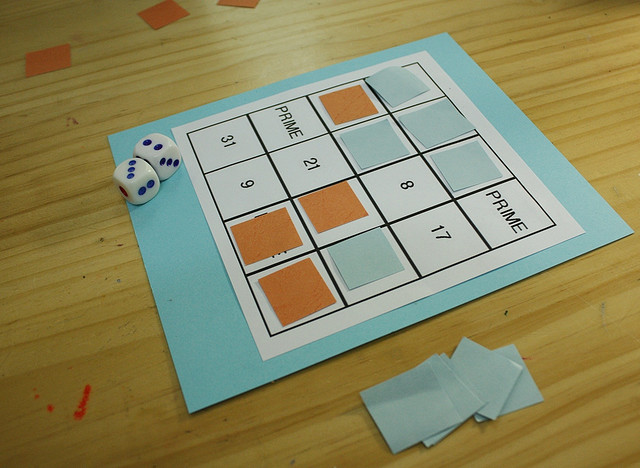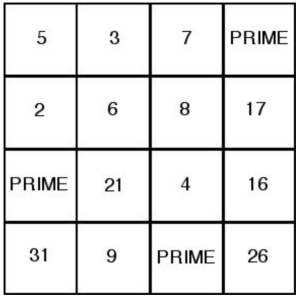Students can explore prime and non-prime numbers with these free favorite classroom games:
For $15-20 you can buy a downloadable file of the beautiful, colorful, mathematical board game Prime Climb. Or pick up the full Prime Climb game box at Amazon.
Or you can try the following game by retired Canadian education professor Jerry Ameis:
Factor Finding Game
Math Concepts: multiples, factors, composite numbers, and primes.
Players: only two.
Equipment: pair of 6-sided dice, 10 squares each of two different colors construction paper, and the game board (click the image to print it, or copy by hand).
On your turn, roll the dice and make a 2-digit number. Use one of your colored squares to mark a position on the game board. You can only mark one square per turn.
- If your 2-digit number is prime, cover a PRIME square.
- If any of the numbers showing are factors of your 2-digit number, cover one of them.
- BUT if there’s no square available that matches your number, you lose your turn.
The first player to get three squares in a row (horizontal, vertical, or diagonal) wins. Or for a harder challenge, try for four in a row.
* * *
This game was featured in the Math Teachers At Play (MTaP) math education blog carnival: MTaP #79. Hat tip: Jimmie Lanley.
This blog is reader-supported.
If you’d like to help fund the blog on an on-going basis, then please join me on Patreon for mathy inspiration, tips, and an ever-growing archive of printable activities.
If you liked this post, and want to show your one-time appreciation, the place to do that is PayPal: paypal.me/DeniseGaskinsMath. If you go that route, please include your email address in the notes section, so I can say thank you.
Which I am going to say right now. Thank you!
“Math Games with Factors, Multiples, and Prime Numbers” copyright © 2015 by Denise Gaskins. Image at the top of the post copyright © Jimmie via flickr (CC BY 2.0).


I greatly enjoy The Factor Game, and have taught it several times. A minor difference from the linked description: My classes have used square boards, e.g., 5×5, 6×6, 7×7. Also, when initially modeling the game, I make sure to play somewhat haphazardly. I do not (as “Mrs. S” describes) begin by playing the best numbers (on a board from 1-30, she begins with 29, and continues with 25: the top moves). We play just enough for students to get the hang of the rules, and then I have them play with one another as I circulate the room to observe and ask about their reasoning.
I also like to start playing with somewhat random moves when I teach a new game to the kids, although I will switch to playing with more strategy after they have learned the game. We have also played on a hundred chart, as mentioned here: 30+ Things to Do with a Hundred Chart.